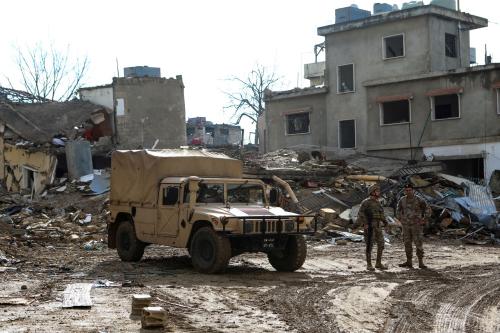An American drone strike that killed leader of the Afghan Taliban Mullah Akhtar Mohammed Mansour may seem like a fillip for the United States’ ally, the embattled government of Afghanistan’s President Ashraf Ghani. But as Vanda Felbab-Brown writes in a new op-ed for The New York Times, it is unlikely to improve Kabul’s immediate national security problems—and may create more difficulties than it solves.
The White House has argued that because Mansour became opposed to peace talks with the Afghan government, removing him became necessary to facilitate new talks. Yet, as Vanda writes in the op-ed, “the notion that the United States can drone-strike its way through the leadership of the Afghan Taliban until it finds an acceptable interlocutor seems optimistic, at best.”
[T]he notion that the United States can drone-strike its way through the leadership of the Afghan Taliban until it finds an acceptable interlocutor seems optimistic, at best.
Mullah Mansour’s death does not inevitably translate into substantial weakening of the Taliban’s operational capacity or a reprieve from what is shaping up to be a bloody summer in Afghanistan. Any fragmentation of the Taliban to come does not ipso facto imply stronger Afghan security forces or a reduction of violent conflict. Even if Mansour’s demise eventually turns out to be an inflection point in the conflict and the Taliban does seriously fragment, such an outcome may only add complexity to the conflict. A lot of other factors, including crucially Afghan politics, influence the capacity of the Afghan security forces and their battlefield performance.
Nor will Mansour’s death motivate the Taliban to start negotiating. That did not happen when it was revealed last July’s the group’s previous leader and founder, Mullah Mohammad Omar, had died in 2013. To the contrary, the Taliban’s subsequent military push has been its strongest in a decade—with its most violent faction, the Haqqani network, striking the heart of Kabul. Mansour had empowered the violent Haqqanis following Omar’s death as a means to reconsolidate the Taliban, and their continued presence portends future violence. Mansour’s successor, Mawlawi Haibatullah Akhundzada, the Taliban’s former minister of justice who loved to issue execution orders, is unlikely to be in a position to negotiate (if he even wants to) for a considerable time as he seeks to gain control and create legitimacy within the movement.
The United States has sent a strong signal to Pakistan, which continues to deny the presence of the Afghan Taliban and the Haqqani network within its borders. Motivated by a fear of provoking the groups against itself, Pakistan continues to show no willingness to take them on, despite the conditions on U.S. aid.
Disrupting the group’s leadership by drone-strike decapitation is tempting militarily. But it can be too blunt an instrument, since negotiations and reconciliation ultimately depend on political processes. In decapitation targeting, the U.S. leadership must think critically about whether the likely successor will be better or worse for the counterinsurgency endgame.
The Brookings Institution is committed to quality, independence, and impact.
We are supported by a diverse array of funders. In line with our values and policies, each Brookings publication represents the sole views of its author(s).



Commentary
What might the drone strike against Mullah Mansour mean for the counterinsurgency endgame?
May 25, 2016